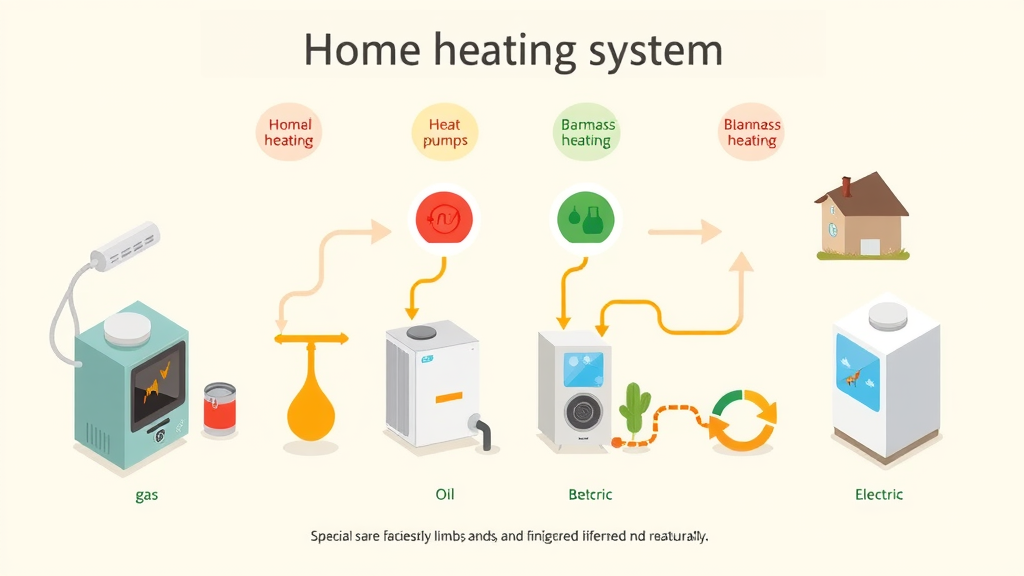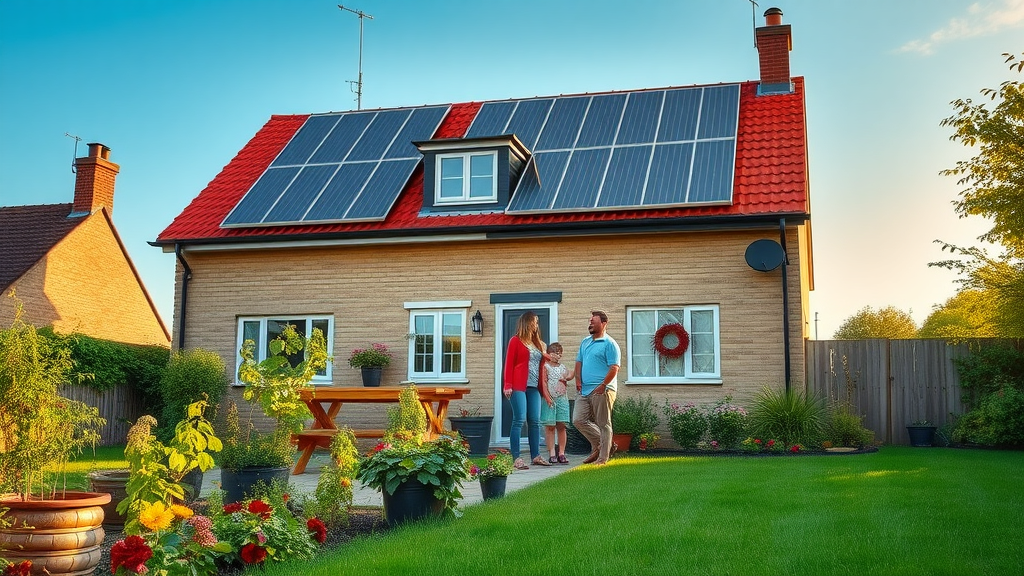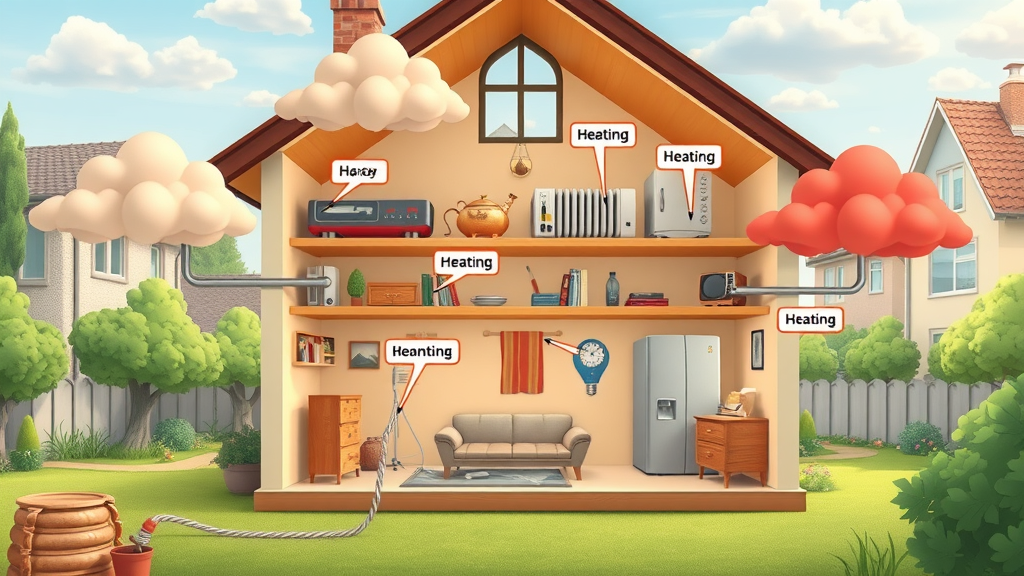
Did you know heating accounts for nearly 37% of the average UK household’s carbon emissions? Shocking, isn’t it? With climate change intensifying and gas bills rising, embracing low carbon footprint heating is no longer just ethical—it’s practical and transformative for every home and the world beyond your doorstep. In this article, I’ll show you why making the upgrade is one of the most impactful choices you can make, reveal surprising truths about carbon heating, and introduce you to the best systems and habits for heating your home efficiently—without warming the planet.
Why Low Carbon Footprint Heating Matters: Surprising Facts and Unconventional Truths
"Heating accounts for nearly 37% of the average household's carbon emissions in the UK—exploring low carbon footprint heating genuinely matters for our future."
Heating our homes is one of the largest contributors to carbon emissions, often surpassing the impact of our cars or daily commutes. While energy consumption from lights and electronics seems obvious, the carbon footprint from burning fossil fuels , such as natural gas or oil in older heating systems , quietly but significantly increases greenhouse gas emissions. The reality is, traditional boilers and heaters not only cost more to run, but they also accelerate climate change through the release of carbon dioxide and other greenhouse gases.
But here's the twist: advances in technology now mean British homes can be both cozy and dramatically less polluting. Innovative heat pumps , biomass boilers , and electric heating systems harness renewable sources, slashing your property’s carbon heat output. The biggest surprise? In many cases, switching to low carbon footprint heating isn’t just better for the earth—it could mean healthier indoor air and even lower energy bills. By understanding, adopting, and advocating for clean heating, we make a powerful statement: we care about the planet and the quality of life for future generations.
What You'll Gain by Embracing Low Carbon Footprint Heating
- Reduce energy consumption and carbon emissions
- Lower energy bills with high efficiency
- Support global climate action and future-saving innovation
- Improve indoor comfort while adopting cutting-edge heating systems

Understanding Low Carbon Footprint Heating: Core Concepts and Modern Standards
What Defines Low Carbon Heating Systems Today?
The term low carbon footprint heating describes heating systems designed to emit as little greenhouse gas as possible—especially carbon dioxide —from their operation. Modern solutions prioritize energy efficiency and the use of renewable or clean sources. For example, an air source heat pump extracts ambient heat from the outside air (even in winter!), multiplying the supplied energy for each unit of electricity consumed. By contrast, traditional natural gas boilers burn fossil fuels, directly releasing emissions.
Low carbon heating systems often feature advanced controls, integration with solar panels, and smart thermostats. Systems like ground source heat pumps tap into the earth’s stable temperatures to heat water for radiators or underfloor systems, while biomass boilers burn sustainably sourced wood pellets or chips—ideally with rigorous sourcing standards. Together, these technologies make it possible to heat a home effectively while keeping carbon emissions (and your carbon footprint) to a minimum.
It’s important to note, however, that not every so-called “green” solution is equally clean. The actual environmental benefit depends on installation quality, local electricity grid mix (how much comes from renewables), and daily usage. That’s why understanding the carbon emissions data of each system is crucial to making a truly low carbon choice.
The Role of Carbon Emissions in Domestic Heating
Heating generates carbon emissions mainly by burning fossil fuels. Gas boilers and oil burners release carbon dioxide directly into the atmosphere, contributing heavily to a home’s annual carbon footprint. Even older forms of electric heating may depend on electricity from power plants that burn coal or gas, unless your region runs on clean, renewable sources.
The effect isn't just abstract—UK homes collectively account for a massive share of the country’s greenhouse gas output. As government standards tighten and the climate crisis worsens, choosing technologies that minimize carbon emissions has major implications for both everyday costs and environmental legacy. New regulations encourage efficient systems like heat pumps and renewable-powered options, signaling a national shift from fossil fuel-reliant heating to cleaner, sustainable alternatives.
By understanding which technologies produce the least emissions—and how their efficiency compares—you can make smart, future-proof choices for your property.
| System Type | Typical Fuel | Annual Carbon Footprint (kg CO2) | Key Factors |
|---|---|---|---|
| Gas Boiler | Natural Gas | 2,200 – 3,000 | Fossil fuel, mid-efficiency |
| Oil Boiler | Heating Oil | 2,500 – 3,800 | Highest emissions, fossil fuel |
| Air Source Heat Pump | Electricity | 500 – 1,000 (with renewables) | High efficiency, low direct emissions |
| Ground Source Heat Pump | Electricity | 400 – 900 (with renewables) | Highest efficiency, lowest emissions |
| Biomass Boiler | Wood Pellets/Chips | 100 – 750 | Depends on sourcing & efficiency |
| Electric Heating | Electricity | 0 (if 100% renewable) – 6,000 | Grid-dependent emissions |

Heat Pump Revolution: The Backbone of Low Carbon Footprint Heating
How Heat Pumps Work: Energy Efficiency Meets Low Carbon
A heat pump is an ingenious way to heat your home by “moving” rather than creating warmth. Air source heat pumps absorb heat from the outside air—even when it feels cold outside—then amplify and transfer it indoors to heat radiators, underfloor systems, or hot water tanks. Ground source heat pumps operate on a similar principle but use buried pipes to extract warmth from the earth.
What makes heat pumps a true game-changer for low carbon heating is their remarkable energy efficiency . For every unit of electricity used, a modern heat pump delivers up to three or four units of heat, drastically reducing your energy consumption. When powered by a renewable electricity supply, the carbon footprint of home heating plummets near zero.
Unlike gas boilers that generate emissions at the source, heat pumps transfer existing energy, cutting both your costs and environmental impact. No wonder government incentives and forward-thinking homeowners are adopting them as a foundation for the UK’s clean energy transition.

Ground Source Heat Pumps vs. Air Source Heat Pumps: Choosing the Best Low Carbon Option
Deciding between ground source heat pumps and air source heat pumps can seem daunting, but the best choice depends on your property and carbon-saving goals. Ground source heat pumps are the gold standard for energy efficiency and carbon reduction , as they draw from the earth’s stable temperature year-round. Their installation, however, is more disruptive and often costlier upfront, as it requires space for underground pipes.
Air source heat pumps are more affordable to install and can be fitted to most UK homes. They work well even in cold climates, needing only a small external unit, and deliver impressive carbon savings —especially when powered by renewable electricity. Both systems slash carbon emissions compared to conventional fossil fuel boilers and can seamlessly provide hot water as well as warmth.
If your primary goal is to minimize your carbon footprint and lower heating costs long-term, either option can deliver substantial benefits. Assess your space, insulation, and budget—or consult a trusted heating professional—for customised advice.
Are Heat Pumps Suitable for Every Home? Expert Opinion on Carbon Emissions and Heating Systems
Heat pumps hold immense promise for low carbon heating —but are they right for every property? In truth, not all homes are ideal candidates. Well-insulated buildings see the greatest efficiency, as heat pumps operate best with steady temperatures and lower-output radiators or underfloor heating. For older properties with poor insulation or very small external spaces, upgrades may be needed first.
That said, modern source heat pumps now perform admirably in a range of British homes. There are compact units for apartments, robust systems for detached houses, and hybrid options that can supplement existing boilers during peak demand. Consulting an expert is crucial: a professional assessment ensures the system matches your property’s needs and maximises carbon emissions reduction.
Ultimately, as the UK moves to decarbonise the grid and improve home efficiency standards, heat pumps are set to become the backbone of low carbon heating—delivering measurable emissions cuts and cost savings to families nationwide.
Biomass Boilers and Renewable Heating Systems: Navigating the 'Low Carbon' Label

Advantages and Limitations of Biomass Boilers
Biomass boilers offer another renewable route to low carbon footprint heating . Unlike gas or oil, these systems burn organic materials like wood pellets, chips, or logs, ideally sourced from well-managed, sustainable forests. Because plants absorb CO2 while growing, burning biomass can be considered “carbon neutral”—if reforestation matches fuel harvesting.
The big advantage is versatility: biomass boilers provide reliable space and water heating , and can easily replace old oil or gas systems in rural homes. They lower reliance on fossil fuels, support local supply chains, and even generate ash suitable for garden compost. However, efficiency varies by fuel quality and usage habits.
On the downside, these systems demand more storage space, require regular maintenance, and may emit tiny particulates or pollutants if not operated cleanly. The upfront cost is also higher than replacing a gas boiler. As with all “low carbon” solutions, real-world carbon savings depend on responsible fuel sourcing and high-efficiency operation.
Are Biomass Boilers Truly Low Carbon? A Critical Perspective
Whether biomass boilers are genuinely “low carbon” is the subject of fierce debate. If wood or pellets are taken from sustainable, well-managed forests, the net greenhouse gas emissions can be much lower than fossil fuels. Yet, if demand increases and forests are not replanted quickly, or fuel is imported from distant locations, emissions from transport and deforestation add up.
Careful consideration of supply chain transparency and local renewable sourcing is paramount. When executed responsibly, biomass heating systems present a viable transition step, especially where heat pumps are impractical. However, they cannot match the ultra-low carbon footprint of heat pumps powered by 100% renewables.
Ultimately, biomass can play a role in the UK’s carbon heating future, primarily as a bridge solution in older, rural, or off-grid properties—provided sustainability criteria are rigorously enforced.
Beyond Heat Pumps: Innovative Low Carbon Footprint Heating Systems
Electric Heating and Smart Controls for Lower Carbon Emissions
Electric heating (including high-efficiency electric radiators and underfloor systems) is another way to achieve low carbon footprint heating —but only if powered by renewable energy. The carbon footprint of an electric system depends entirely on the eco-friendliness of the grid or your home’s onsite generation.
Smart thermostats and zoning controls play a vital role here. Intelligent systems like smart heating controls adapt to your lifestyle and weather patterns, making real-time adjustments that avoid overheating and unnecessary energy consumption. By minimising waste, you cut both costs and carbon emissions. When paired with renewables, these smart systems are a simple, scalable solution for modern homes, especially new builds and flats.
For existing dwellings, upgrading to programmable thermostats and adding smart valves to radiators can reduce carbon emissions without a major overhaul. Combine these with routine insulation improvements for even greater impact.

Combining Solar Thermal with Water Heating Systems
Solar thermal panels harness free energy from the sun to heat water, reducing your dependence on fossil fuels or grid electricity for baths, showers, and radiators. In the UK’s climate, a well-designed water heating system can supply 50%–60% of your hot water needs from April to September—making every sunny day an opportunity to lower your carbon footprint .
Solar thermal integrates especially well with heat pumps and other efficient heating systems . By storing excess heat in insulated tanks, you gain flexibility and resilience—even during energy price shocks. Installation is unobtrusive and works seamlessly with existing hot water cylinders.
The result? Lower bills, less reliance on the grid, and another step toward a carbon heating future that’s truly sustainable. To maximise benefit, invest in high-quality collectors, a professional setup, and regular maintenance.

The Future of Carbon Heating: Hydrogen and Beyond
Looking ahead, hydrogen technologies and hybrid systems are poised to reshape the UK’s heating landscape. Hydrogen can be blended into existing natural gas networks or used for cutting-edge boilers, potentially offering near-zero carbon emissions at the point of use. Pilot projects across Britain are testing hydrogen’s safety, efficiency, and scalability.
Other future-ready solutions include district heating (community-level systems powered by renewables or waste heat), advanced storage batteries, and heat networks that share low carbon energy between households. The pace of innovation means that “future proofing” your home may soon involve flexible technologies that shift easily between electric, solar, and hydrogen-based options as the grid itself gets greener.
Staying informed and adaptable will ensure your heating system delivers both comfort and relentless progress toward a truly low carbon future.
Reducing Carbon Footprint When Heating: Personal and Policy Perspective

Switching from Natural Gas: Practical Steps to Low Carbon Heating
The journey to low carbon footprint heating often begins with replacing your natural gas or oil boiler. Evaluate options like air source heat pumps , ground source heat pumps , or modern electric systems for your property. Planning is key: proper insulation, radiator upgrades, and smart thermostats will supercharge your savings and maximise carbon reduction.
Next, research available grants and incentives for installing heat pumps or renewables. The UK government offers various schemes to ease the upfront cost of greener systems. Seek out local, MCS-certified professionals for advice and installation—expertise can make all the difference in performance and longevity, and ensures compliance with the newest carbon heating standards.
Finally, nurture low-carbon habits: regular servicing, temperature moderation, and a switch to green electricity tariffs further offset carbon emissions. Every step away from fossil fuels strengthens your home against climate change and future-proofs your comfort.
Improving Home Efficiency: Insulation, Smart Thermostats, and Consumption Habits
Before pouring money into a new heating system , stop heat leaks! Upgrade your home’s insulation—loft, cavity walls, and windows—to lock in warmth and boost efficiency, no matter the system. Adding advanced thermostatic controls lets you heat only rooms in use and automatically responds to your daily routine, ensuring no extra energy is wasted.
Cultivate conscious heating habits, like shutting curtains at night, blocking draughts, and keeping doors shut between rooms. Small changes, multiplied daily, dwindle carbon output and decrease bills.
For maximum impact, combine efficient building fabric with the latest smart controls and a low carbon system—delivering comfort, savings, and a dramatic reduction in carbon emissions.
- Quick ways to reduce your heating-related carbon emissions
- Choosing the right heating system for your property
- Smart controls and maintenance tips for maximum savings
People Also Ask: Essential Low Carbon Footprint Heating Questions Answered
What are the low carbon heating methods?
Low carbon heating methods include heat pumps (both air source and ground source), biomass boilers, electric heating using renewable energy sources, solar water heating, and advanced hydrogen boilers. All prioritize minimal greenhouse gas emissions and high energy efficiency.
What is the carbon footprint of heating a house?
The carbon footprint of heating a house varies by system: gas boilers average 2.2 to 3 metric tons CO2 annually, electric heating can range from 0 (with renewables) up to 6 tons, and heat pumps can lower annual emissions to less than 1 ton when run on green energy.

What is one way that you can reduce your carbon footprint when heating your home?
Install a heat pump and improve your insulation. These measures can cut your heating-related carbon emissions by over 50%, according to recent studies.
What has the lowest carbon footprint?
Heating powered entirely by renewable electricity—paired with a high-efficiency heat pump—currently delivers the lowest carbon footprint for residential heating.
From Insight to Action: Making the Switch to a Low Carbon Footprint Heating System
- Consult a heating professional
- Check your home’s insulation before investing
- Evaluate government incentives/grants for low carbon systems
- Prioritise long-term carbon savings over initial cost
"Every green choice starts at home—by reducing carbon emissions from heating, we all shape a cleaner future."

Frequently Asked Questions on Low Carbon Footprint Heating
Are heat pumps noisy or disruptive?
Modern heat pumps are designed to run quietly, especially when professionally installed. Most make less noise than a typical refrigerator and are not disruptive for daily living. Placement and proper maintenance further minimise any audible impact, making them well-suited for residential settings.
How do government policies support low carbon heating adoption?
UK government policies increasingly favour low carbon heating , offering incentives like the Boiler Upgrade Scheme and renewable heat grants. Regulations encourage replacing old fossil fuel systems with heat pumps, solar, or efficient electrics, and fuel duty is shifting to penalise higher-carbon systems. These policies ease transition and make adopting clean heating systems more affordable.
Is low carbon heating more expensive in the long run?
While some low carbon heating systems require a higher initial investment, long-term savings on fuel, lower maintenance costs, and government support schemes often make them more affordable over their lifespan. Improved energy efficiency leads to lower bills, making the upfront cost worthwhile for both your wallet and the environment.
Make Your Home Greener with Low Carbon Footprint Heating Solutions Today
"Begin your transformation now—each step toward lower carbon heating is an investment in your future and the planet."
- Contact Ed Serrell Plumbing and Heating for custom advice on low carbon footprint heating
- Call 0796 688 4368 or email info@edsplumbing.co.uk for trusted guidance
Ready to slash your energy bills and carbon emissions? Act today: consult an expert, upgrade your insulation, and explore incentives for low carbon heating systems. Your home—and our planet—will thank you.
Sources
- Home Heating Guide – https://www.gov.uk/guidance/home-heating-guide
- Energy Saving Trust – https://energysavingtrust.org.uk/advice/heat-pumps/
- Carbon Trust – https://www.carbontrust.com/resources/a-guide-to-heat-pumps
- Committee on Climate Change – https://www.theccc.org.uk/
To further enhance your understanding of low carbon footprint heating, consider exploring the following resources:
-
“A Quick Guide to Low Carbon Heating” by the Energy Saving Trust provides an overview of various low-carbon heating technologies, including solar water heating and heat pumps, detailing their benefits and considerations. ( energysavingtrust.org.uk )
-
“The Best Low-Carbon Heating Solutions Explained” by OVO Energy offers insights into different low-carbon heating options, such as solar thermal panels and heat pumps, and discusses their efficiency and environmental impact. ( ovoenergy.com )
These resources offer valuable information to help you make informed decisions about adopting low-carbon heating solutions for your home.
 Add Row
Add Row  Add
Add 




Write A Comment